THE CINEMA
" Shors." At the Tatler.—" Suspicion." At the Odeon. " March of Time." At the Gaumont.
Shors is a disappointment. It was made by Dovzhenko, who many years ago directed Earth, probably the most beautiful film ever made. Recalling the profound insight which Earth revealed into the relationship between a peasant people and the soil by which it lives, one hoped to find the same fertile imagery in this later film of the Ukraine. But Shors, completed in 1939, was the result of a suggestion made by Stalin to Dovzhenko at a time when the film policy of the U.S.S.R. required screen heroes to be famous soldiers, and preferred the technique of a Holly- wood western to the symbolisms of visual- poetry. So that Shors is full of hard riding and fighting, but contains only one recognisably human character. The story is of the fight of Ukrainian guerillas in 1918-19, first against the Germans and then against the reactionaries under Petlura. Shors, the leader of the guerillas, is an intellectual of whose character nothing is revealed except his fanatical devotion to the revolution. The minor characters are equally unrounded, but Bozhenko, a pro- revolutionary regular soldier, is delightfully drawn. The principal interest of the film lies in the relationship between the immaculate Shors and this bibulous and undisciplined old pro- fessional warrior who supported the revolution not because of any recognition of political ideologies, but because he loved his men and hated the bourgeoisie. Bozhenko dies, and there is an effective sequence in which his mourning men carry his body slowly across a vast Ukrainian plain whilst shells explode on every side and the whole horizon above the ungathered corn is dark with smoke from the blazing homes of the peasants. The battle scenes often remind us of history repeating itself today, but for the most part the fighting is confused, and the film is so shapeless that it. gives little idea of the progress of this great campaign, which in its outcome foreshadows the course of the present war in the Ukraine.
Suspicion is a most exasperating film. The early development is maddeningly slow, but by the time we get to the later reels, director Hitchcock is in his stride (though never in his British studio form), and Cary Grant and Joan Fontaine have suc- ceeded in building up two unconventional though credible characters. We accept a situation in which a gay and charm- ing English society play-boy has lied and embezzled his way into acute financial embarrassment, and is proceeding to save himself from prison by murdering his best friend, and by planning the murder of his devoted but scrupulously honest wife. We enjoy the brilliance with which Joan Fontaine portrays the growing suspicions of the wife. We watch love struggle with the cold- eyed repulsion which she begins to show for this smiling monster who is threatening her life. We watch the increasingly frequent outbursts of rage with which he frustrates her attempts to leave him. The evidence of his past crimes and future purpose pile up remorselessly. He lies about his whereabouts on the night his friend is murdered, he investigates his wife's insurance policy, he inquires about new poisons. We are ready for the climax, and await the finishing touch to this laborious but convincing portrait of a murderer. Then, suddenly, the original and the logical story is completely abandoned. With a maddening contempt for the carefully constructed plot, someone remembers the old money-making prejudice against tragic end- ings, and we are blithely informed—with no convincing explana- tion—that our hero is no murderer or would-be murderer, but just a nice, simple-hearted little embezzler with a suspicious wife. The couple retreat from the brink of the cliff to which the wife had been brought with every expectation of being pushed over, and they drive off home happily with all forgiven. Her husband had merely meant to commit suicide. There is little sign of Hitchcock's old skill in creating minor characters, and the English backgrounds are all good Hollywood. Suspense is often nicely handled towards the end of the picture, but it was going rather far to make so much use of letters and printed matter when the character who must read the print always took so long to adjust her spectacles. Suspicion is well worth seeing for Joan Fontaine's performance—but don't forget to leave while it's still a murder film.
The latest March of Time is the best for many months. Entitled Sailors With Wings, it deals with the history and present status of U.S. naval aviation. The flying sequences of patrolling and dive-bombing are beautifully photographed, and the scenes taken on aircraft-carriers, particularly the enormous vistas of the hangars, are amongst the most spectacular pictures of the machinery of modern war that have ever been photographed. The film includes scenes of the world's first aircraft-carrier- a converted U.S. collier. The American navy claims also to have invented dive-bombing and torpedo-bombing. Sailors With Wings was completed before the Japanese attack on America, and the film now arouses a poignant hope that the many new types of aircraft included in the film are possessed in adequate num- bers. Whether they are or not, the airmen who move through this stirring film have about them a determination and a pride in their work and shining equipment which augurs well for the


























 Previous page
Previous page